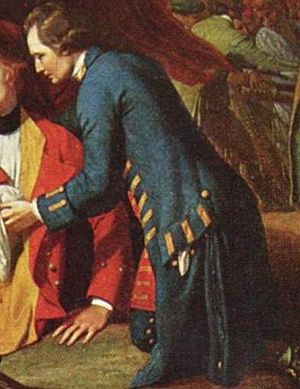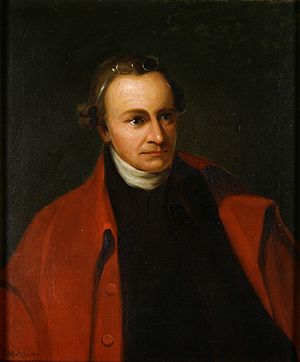Thomas Hinde facts for kids
Quick facts for kids
Dr Thomas Hinde
|
|
|---|---|
 |
|
| Born | July 10, 1737 |
| Died | September 28, 1828 (aged 91) |
| Nationality | British (1737 – late 1760s); American (late 1760s – 1828) |
| Alma mater | St. Thomas's Hospital (studied under Dr Thomas Brookes) now called King's College London School of Medicine |
| Occupation | Physician |
| Spouse(s) | Mary Todd Hubbard |
| Children |
|
| Relatives | Charles T. Hinde (grandson) Edmund C. Hinde (grandson) Frederick Hinde Zimmerman (great-grandson) Harry Hinde (great-grandson) Richard Southgate (son-in-law) William Wright Southgate (grandson) |
Doctor Thomas Hinde (born July 10, 1737 – died September 28, 1828) was a very important doctor in early Northern Kentucky. He was the first physician in that area. Before that, he was a doctor in the British Royal Navy. He also helped the American Revolution and was the personal doctor for Patrick Henry, a famous American founding father. Dr. Hinde was even there when General Wolfe died in Quebec, Canada. He lived to be 91 years old, which was very old for his time!
Contents
Dr. Thomas Hinde: A Life of Service
Thomas Hinde is considered the main ancestor of the Hinde family in the United States. His youngest son, Thomas S. Hinde, became a well-known Methodist minister and businessman. His grandson, Charles T. Hinde, was a successful shipping leader. Another grandson, Edmund C. Hinde, was an adventurer. Other family members, like the Kavanaugh and Southgate families, became leaders in politics and the Methodist church.
As Patrick Henry's personal doctor, Hinde played a key role in the American Revolutionary War. He gave vaccinations against smallpox and treated injured soldiers. Because of his service, he received a large piece of land in Kentucky. He moved there with his family. A special monument was built in Campbell County, Kentucky to honor his services to the state.
Early Years and Medical Training
Thomas Hinde was born in Oxfordshire, England, in July 1737. He went to school in Oxfordshire. After finishing his studies, he moved to London to study medicine. He learned about physics and surgery from Dr. Thomas Brooke at St Thomas' Hospital. When he was 19, he got his license to practice medicine.
Soon after, he joined the Royal Navy as a Surgeons' Mate. He sailed to America with the forces led by General Amherst. He arrived in New York on June 10, 1757. He spent time in Halifax and Louisbourg. In the winter of 1758, he helped General Amherst in Louisbourg. He was also on the ship that carried General James Wolfe to Quebec.
The Death of General Wolfe
General Wolfe died in Dr. Hinde's arms during the 1759 Battle of Quebec. This battle was part of the Seven Years' War. Dr. Hinde later said that his time with General Wolfe and his experiences in Quebec were some of the most important parts of his life.
A famous painting shows Dr. Hinde helping General Wolfe as he dies. The painting is called The Death of General Wolfe and was made by Benjamin West. West made a similar painting for King George III in 1771. After Wolfe's death, Hinde stayed in the British Navy. He was present when Bell'isle was captured. He was later promoted and continued as a doctor for a warship after the peace treaty in 1763. He eventually left the Navy.
Copies of West's painting are in many places. You can see them at the National Gallery of Canada and the Royal Ontario Museum. There are also copies at the William L. Clements Library in Michigan and at Ickworth House in England.
Settling in America
After the Battle of Quebec, Dr. Hinde went back to England for a short time. Peace with France was made in 1763. Then, Hinde returned to Virginia and decided to live there. He became good friends with a Virginian who convinced him to practice medicine in Essex County, Virginia.
Another story says that an older doctor in Virginia asked Dr. Thomas Brooke, Hinde's teacher, to send a young doctor to help him. Brooke chose Hinde and told him to take the opportunity. Hinde accepted. But he soon moved to Newton, where he met his future wife. After they got married, Hinde moved again and settled in Hanover County, Virginia.
Doctor to a Founding Father
In 1765, after settling in Virginia, Hinde met Patrick Henry. Henry was one of the founding fathers of the United States. He also met Samuel Davis and Lord Dunmore. Two years later, Hinde married Mary T. Hubbard. He settled near Patrick Henry and became his family doctor. Being friends with Henry helped Hinde meet many important people in Virginia.
Hinde found Mary T. Hubbard to be a very lively and smart person. They got married on September 24, 1767. At first, Hinde was very loyal to the British King. But after meeting Patrick Henry, he became a strong supporter of American independence.
Helping Soldiers in the Revolution
Hinde played an active part in the American Revolutionary War. He served as a surgeon with Patrick Henry in different battles. During the 1775 Gunpowder Incident, Hinde was the Chief Surgeon for Patrick Henry. This event made him fully support the American colonies against Lord Dunmore and the British King. The Gunpowder Incident was an early conflict between Lord Dunmore, the British Governor of Virginia, and American fighters led by Henry.
Hinde wanted to be on the front lines with Henry's soldiers. But when Henry became Governor, Hinde was asked to give vaccinations to all soldiers in the American army. The army did not have enough money, so Hinde had to pay for some of the vaccinations himself. After the war, Hinde continued to live in Hanover County and mostly worked as a doctor.
Moving to Kentucky
After the American Revolutionary War, Dr. Hinde moved his family from Virginia to Kentucky. He received a large land grant for his services in the war. He had not been paid all his salary. Because he was such a skilled surgeon, the Virginians gave him a special land warrant. This warrant allowed him to choose 20,000 acres of land in Kentucky. Patrick Henry was supposed to help him find and claim the land.
For reasons we don't know, Patrick Henry could not finish the land grant for Hinde. So, Hinde sent his nephew, Hubbard Taylor, to Kentucky to find the land and complete the deal. Hinde gave Taylor half of the land for his help. The land was in Clark County, Kentucky, between Winchester and Lexington.
His Spiritual Journey
When he was young in England, Hinde was a member of the Church of England. But as an adult, he left the church and became a Deist. This meant he believed in God but not in organized religion. One writer said that for a while, Hinde enjoyed making fun of Christianity. However, later in his life, his religious views changed a lot.
In 1798, Methodist ministers came to Hinde's area and started converting people. Susanna, one of Hinde's daughters, became a Methodist. This upset the family. Hinde sent her away to live with her aunt. But this did not work because her aunt had also become a Methodist. Soon after, Hinde's wife also converted.
Hinde thought his wife and daughter were sick. He tried to treat them with medical procedures of the time. These procedures were painful. But his wife said later, "it was a punishment, but I never was so happy in all my life." Hinde later felt bad for what he had done. He then converted to Methodism himself. His daughter came home, and his wife started going to Methodist meetings regularly. Two of his daughters married traveling preachers, and another daughter also became a Methodist. By the end of his life, Hinde was a very religious Methodist.
One of Hinde's grandchildren said that Hinde built "little houses of sticks and wood" where he would pray. The grandchildren called them "Grandpa's prayer-houses." You could hear Hinde praying from far away.
His Family Legacy
Hinde married Mary Todd Hubbard, who was the daughter of an English merchant named Benjamin Hubbard. They were married for 61 years! They had eight children who lived to be adults. His daughter Ann Winston Hinde married Richard Southgate on July 30, 1799, in Newport, Kentucky. Hinde and his family were members of the Grace Methodist Episcopal Church in Newport, Kentucky.
One of Hinde's sons was Thomas S. Hinde. He helped start Mount Carmel, Illinois, and became a respected Methodist minister. Hinde's grandson, Captain Charles T. Hinde, was a successful businessman and riverboat captain. Charles was one of the main investors in the Hotel del Coronado in San Diego, California. He also inspired Frederick Hinde Zimmerman, Dr. Hinde's great-grandson, to build the Grand Rapids Hotel in Mount Carmel, Illinois.
In his later years, Hinde lived with his daughter Mary McKinney in Newport, Kentucky.



